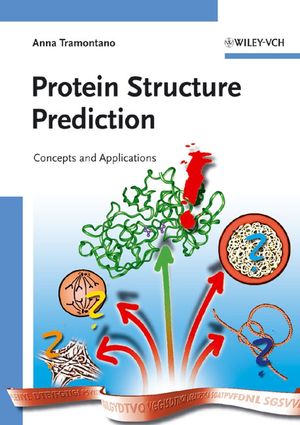Protein Structure Prediction: Concepts and ApplicationsISBN: 978-3-527-31167-5
Paperback
228 pages
February 2006
 |
||||||
Foreword vii
Preface xii
Acknowledgments xv
Introduction xvi
1 Sequence, Function, and Structure Relationships 1
1.1 Introduction 1
1.2 Protein Structure 4
1.3 The Properties of Amino Acids 12
1.4 Experimental Determination of Protein Structures 14
1.5 The PDB Protein Structure Data Archive 20
1.6 Classification of Protein Structures 22
1.7 The Protein-folding Problem 24
1.8 Inference of Function from Structure 27
1.9 The Evolution of Protein Function 29
1.10 The Evolution of Protein Structure 34
1.11 Relationship Between Evolution of Sequence and Evolution of Structure 37
2 Reliability of Methods for Prediction of Protein Structure 41
2.1 Introduction 41
2.2 Prediction of Secondary Structure 43
2.3 Prediction of Tertiary Structure 46
2.4 Benchmarking a Prediction Method 50
2.5 Blind Automatic Assessments 51
2.6 The CASP Experiments 51
3 Ab-initio Methods for Prediction of Protein Structures 55
3.1 The Energy of a Protein Configuration 55
3.2 Interactions and Energies 55
3.3 Covalent Interactions 56
3.4 Electrostatic Interactions 58
3.5 Potential-energy Functions 62
3.6 Statistical-mechanics Potentials 62
3.7 Energy Minimization 65
3.8 Molecular Dynamics 66
3.9 Other Search Methods: Monte Carlo and Genetic Algorithms 67
3.10 Effectiveness of Ab-initio Methods for Folding a Protein 70
4 Evolutionary-based Methods for Predicting Protein Structure: Comparative Modeling 73
4.1 Introduction 73
4.2 Theoretical Basis of Comparative Modeling 75
4.3 Detection of Evolutionary Relationships from Sequences 77
4.4 The Needleman and Wunsch Algorithm 79
4.5 Substitution Matrices 81
4.6 Template(s) Identification Part I 84
4.7 The Problem of Domains 90
4.8 Alignment 91
4.9 Template(s) Identification Part II 96
4.10 Building the Main Chain of the Core 97
4.11 Building Structurally Divergent Regions 98
4.12 A Special Case: Immunoglobulins 102
4.13 Side-chains 106
4.14 Model Optimization 107
4.15 Other Approaches 108
4.16 Effectiveness of Comparative Modeling Methods 109
5 Sequence-Structure Fitness Identification: Fold-recognition Methods 117
5.1 The Theoretical Basis of Fold-recognition 117
5.2 Profile-based Methods for Fold-recognition 119
5.3 Threading Methods 121
5.4 Profile–Profile Methods 124
5.5 Construction and Optimization of the Model 124
6 Methods Used to Predict New Folds: Fragment-based Methods 127
6.1 Introduction 127
6.2 Fragment-based Methods 128
6.3 Splitting the Sequence into Fragments and Selecting Fragments from the Database 130
6.4 Generation of Structures 135
7 Low-dimensionality Prediction: Secondary Structure and Contact Prediction 137
7.1 Introduction 137
7.2 A Short History of Secondary structure Prediction Methods 140
7.3 Automatic learning Methods 142
7.3.1 Artificial Neural Networks 142
7.3.2 Support Vector Machines 148
7.4 Secondary structure Prediction Methods Based on Automatic Learning Techniques 150
7.5 Prediction of Long-range Contacts 153
8 Membrane Proteins 159
8.1 Introduction 159
8.2 Prediction of the Secondary Structure of Membrane Proteins 162
8.3 The Hydrophobic Moment 165
8.4 Prediction of the Topology of Membrane Proteins 166
9 Applications and Examples 169
9.1 Introduction 169
9.2 Early Attempts 169
9.3 The HIV Protease 171
9.4 Leptin and Obesity 174
9.5 The Envelope Glycoprotein of the Hepatitis C Virus 176
9.6 HCV Protease 178
9.7 Cyclic Nucleotide Gated Channels 181
9.8 The Effectiveness of Models of Proteins in Drug Discovery 183
9.9 The Effectiveness of Models of Proteins in X-ray Structure Solution 186
Conclusions 188
Glossary 190
Index 201



